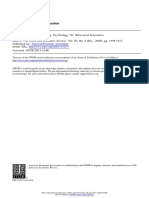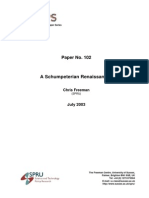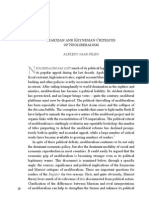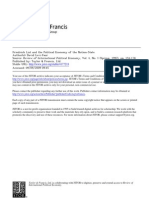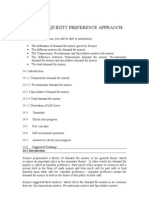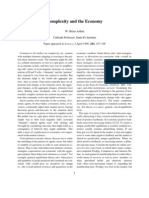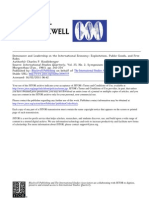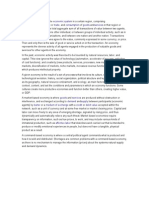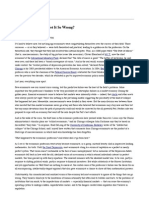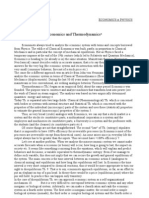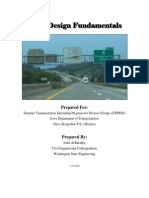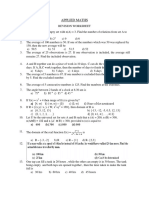Neo Classical Economics
Neo Classical Economics
Uploaded by
LadiaBagrasCopyright:
Available Formats
Neo Classical Economics
Neo Classical Economics
Uploaded by
LadiaBagrasOriginal Description:
Copyright
Available Formats
Share this document
Did you find this document useful?
Is this content inappropriate?
Copyright:
Available Formats
Neo Classical Economics
Neo Classical Economics
Uploaded by
LadiaBagrasCopyright:
Available Formats
Neoclassical economics
Neoclassical economics is a term variously used for approaches to economics focusing on the
determination of prices, outputs, and incomedistributions in markets through supply and demand,
often mediated through a hypothesized maximization of utility by income-constrained individuals and
of profits by cost-constrained firms employing available information and factors of production, in
accordance with rational choice theory.
[1]
Neoclassical economics dominates microeconomics, and together with Keynesian economics forms
the neoclassical synthesis which dominatesmainstream economics today.
[2]
Although neoclassical
economics has gained widespread acceptance by contemporary economists, there have been many
critiques of neoclassical economics, often incorporated into newer versions of neoclassical theory.
Contents
1 Overview
o 1.1 Three central assumptions
2 Origins
3 The marginal revolution
4 Further developments
5 Criticisms
Overview
The term was originally introduced by Thorstein Veblen in his 1900 article 'Preconceptions of
Economic Science', in which he related marginalistsin the tradition of Alfred Marshall et al. to those
in the Austrian School.
[3][4]
"No attempt will here be made even to pass a verdict on the relative claims of the recognized two or
three main "schools" of theory, beyond the somewhat obvious finding that, for the purpose in hand,
the so-called Austrian school is scarcely distinguishable from the neo-classical, unless it be in the
different distribution of emphasis. The divergence between the modernized classical views, on the
one hand, and the historical and Marxist schools, on the other hand, is wider, so much so, indeed,
as to bar out a consideration of the postulates of the latter under the same head of inquiry with the
former." Veblen
[5]
It was later used by John Hicks, George Stigler, and others
[6]
to include the work of Carl
Menger, William Stanley Jevons, Lon Walras, John Bates Clark, and many others.
[3]
Today it is
usually used to refer to mainstream economics, although it has also been used as an umbrella
termencompassing a number of other schools of thought,
[7]
notably excluding institutional
economics, various historical schools of economics, andMarxian economics, in addition to various
other heterodox approaches to economics.
Neoclassical economics is characterized by several assumptions common to many schools of
economic thought. There is not a complete agreement on what is meant by neoclassical economics,
and the result is a wide range of neoclassical approaches to various problem areas and domains
ranging from neoclassical theories of labor to neoclassical theories of demographic changes.
Three central assumptions
It was expressed by E. Roy Weintraub that neoclassical economics rests on three assumptions,
although certain branches of neoclassical theory may have different approaches:
[8]
1. People have rational preferences between outcomes that can be identified and associated
with values.
2. Individuals maximize utility and firms maximize profits.
3. People act independently on the basis of full and relevant information.
From these three assumptions, neoclassical economists have built a structure to understand the
allocation of scarce resources among alternative endsin fact understanding such allocation is
often considered the definition of economics to neoclassical theorists. Here's how William Stanley
Jevons presented "the problem of Economics".
"Given, a certain population, with various needs and powers of production, in possession of certain
lands and other sources of material: required, the mode of employing their labour which will
maximize the utility of their produce."
[9]
From the basic assumptions of neoclassical economics comes a wide range of theories about
various areas of economic activity. For example, profit maximization lies behind the
neoclassicaltheory of the firm, while the derivation of demand curves leads to an understanding
of consumer goods, and the supply curve allows an analysis of the factors of production. Utility
maximization is the source for the neoclassical theory of consumption, the derivation of demand
curves for consumer goods, and the derivation of labor supply curves and reservation demand.
[10]
Market supply and demand are aggregated across firms and individuals. Their interactions
determine equilibrium output and price. The market supply and demand for each factor of production
is derived analogously to those for market final output to determine equilibrium income and the
income distribution. Factor demand incorporates the marginal-productivityrelationship of that factor
in the output market.
[6][11][12][13]
Neoclassical economics emphasizes equilibria, where equilibria are the solutions
of agent maximization problems. Regularities in economies are explained by methodological
individualism, the position that economic phenomena can be explained by aggregating over the
behavior of agents. The emphasis is on microeconomics. Institutions, which might be considered as
prior to and conditioning individual behavior, are de-emphasized. Economic
subjectivism accompanies these emphases. See also general equilibrium.
Origins
Classical economics, developed in the 18th and 19th centuries, included a value
theory and distribution theory. The value of a product was thought to depend on the costs involved in
producing that product. The explanation of costs in Classical economics was simultaneously an
explanation of distribution. A landlord received rent, workers received wages, and a capitalist tenant
farmer received profits on their investment. This classic approach included the work of Adam
Smith and David Ricardo.
However, some economists gradually began emphasizing the perceived value of a good to the
consumer. They proposed a theory that the value of a product was to be explained with differences
in utility (usefulness) to the consumer. (In England, economists tended to conceptualize utility in
keeping with the Utilitarianism of Jeremy Bentham and later of John Stuart Mill.)
The third step from political economy to economics was the introduction of marginalism and the
proposition that economic actors made decisions based on margins. For example, a person decides
to buy a second sandwich based on how full he or she is after the first one, a firm hires a new
employee based on the expected increase in profits the employee will bring. This differs from the
aggregate decision making of classical political economy in that it explains how vital goods such as
water can be cheap, while luxuries can be expensive.
The marginal revolution
The change in economic theory from classical to neoclassical economics has been called the
'marginal revolution', although it has been argued that the process was slower than the term
suggests.
[14]
It is frequently dated from William Stanley Jevons's Theory of Political
Economy (1871), Carl Menger's Principles of Economics (1871), and Lon Walras's Elements of
Pure Economics (18741877). Historians of economics and economists have debated:
Whether utility or marginalism was more essential to this revolution (whether the noun or the
adjective in the phrase "marginal utility" is more important)
Whether there was a revolutionary change of thought or merely a gradual development and
change of emphasis from their predecessors
Whether grouping these economists together disguises differences more important than their
similarities.
[15]
In particular, Jevons saw his economics as an application and development of Jeremy Bentham's
utilitarianism and never had a fully developed general equilibrium theory. Menger did not embrace
this hedonic conception, explained diminishing marginal utility in terms of subjective prioritization of
possible uses, and emphasized disequilibrium and the discrete; further Menger had an objection to
the use of mathematics in economics, while the other two modeled their theories after 19th century
mechanics.
[16]
Jevons built on the hedonic conception of Bentham or of Mill, while Walras was more
interested in the interaction of markets than in explaining the individual psyche.
[15]
Alfred Marshall's textbook, Principles of Economics (1890), was the dominant textbook in England a
generation later. Marshall's influence extended elsewhere; Italians would complimentMaffeo
Pantaleoni by calling him the "Marshall of Italy". Marshall thought classical economics attempted to
explain prices by the cost of production. He asserted that earlier marginalists went too far in
correcting this imbalance by overemphasizing utility and demand. Marshall thought that "We might
as reasonably dispute whether it is the upper or the under blade of a pair of scissors that cuts a
piece of paper, as whether value is governed by utility or cost of production".
Marshall explained price by the intersection of supply and demand curves. The introduction of
different market "periods" was an important innovation of Marshalls:
Market period. The goods produced for sale on the market are taken as given data, e.g. in a fish
market. Prices quickly adjust to clear markets.
Short period. Industrial capacity is taken as given. The level of output, the level of employment,
the inputs of raw materials, and prices fluctuate to equate marginal cost and marginal revenue,
where profits are maximized. Economic rents exist in short period equilibrium for fixed factors,
and the rate of profit is not equated across sectors.
Long period. The stock of capital goods, such as factories and machines, is not taken as given.
Profit-maximizing equilibria determine both industrial capacity and the level at which it is
operated.
Very long period. Technology, population trends, habits and customs are not taken as given, but
allowed to vary in very long period models.
Marshall took supply and demand as stable functions and extended supply and demand
explanations of prices to all runs. He argued supply was easier to vary in longer runs, and thus
became a more important determinant of price in the very long run.
Further developments
An important change in neoclassical economics occurred around 1933. Joan Robinson and Edward
H. Chamberlin, with the near simultaneous publication of their respective books, The Economics of
Imperfect Competition (1933) and The Theory of Monopolistic Competition (1933), introduced
models of imperfect competition. Theories of market forms and industrial organization grew out of
this work. They also emphasized certain tools, such as the marginal revenue curve.
Joan Robinson's work on imperfect competition, at least, was a response to certain problems of
Marshallian partial equilibrium theory highlighted by Piero Sraffa. Anglo-American economists also
responded to these problems by turning towards general equilibrium theory, developed on the
European continent by Walras and Vilfredo Pareto. J. R. Hicks's Value and Capital (1939) was
influential in introducing his English-speaking colleagues to these traditions. He, in turn, was
influenced by the Austrian School economist Friedrich Hayek's move to the London School of
Economics, where Hicks then studied.
These developments were accompanied by the introduction of new tools, such as indifference
curves and the theory of ordinal utility. The level of mathematical sophistication of neoclassical
economics increased. Paul Samuelson's Foundations of Economic Analysis (1947) contributed to
this increase in mathematical modelling.
The interwar period in American economics has been argued to have been pluralistic, with
neoclassical economics and institutionalism competing for allegiance. Frank Knight, an earlyChicago
school economist attempted to combine both schools. But this increase in mathematics was
accompanied by greater dominance of neoclassical economics in Anglo-American universities after
World War II. Some
[17]
argue that outside political interventions, such as McCarthyism, and internal
ideological bullying played an important role in this rise to dominance.
Hicks' book, Value and Capital had two main parts. The second, which was arguably not
immediately influential, presented a model of temporary equilibrium. Hicks was influenced directly by
Hayek's notion of intertemporal coordination and paralleled by earlier work by Lindhal. This was part
of an abandonment of disaggregated long run models. This trend probably reached its culmination
with the Arrow-Debreu model of intertemporal equilibrium. The Arrow-Debreu model has canonical
presentations in Grard Debreu's Theory of Value (1959) and in Arrow and Hahn's "General
Competitive Analysis" (1971).
Many of these developments were against the backdrop of improvements in both econometrics, that
is the ability to measure prices and changes in goods and services, as well as their aggregate
quantities, and in the creation of macroeconomics, or the study of whole economies. The attempt to
combine neo-classical microeconomics and Keynesian macroeconomics would lead to
the neoclassical synthesis
[18]
which has been the dominant paradigm of economic reasoning in
English-speaking countries since the 1950s. Hicks and Samuelson were for example instrumental in
mainstreaming Keynesian economics.
Macroeconomics influenced the neoclassical synthesis from the other direction, undermining
foundations of classical economic theory such as Say's Law, and assumptions about political
economy such as the necessity for a hard-money standard. These developments are reflected in
neoclassical theory by the search for the occurrence in markets of the equilibrium conditions
of Pareto optimality and self-sustainability.
Criticisms
Main article: Criticisms of neoclassical economics
Neoclassical economics is sometimes criticized for having a normative bias. In this view, it does not
focus on explaining actual economies, but instead on describing a "utopia" in which Pareto
optimality applies.
[19]
The assumption that individuals act rationally may be viewed as ignoring important aspects of
human behavior. Many see the "economic man" as being quite different from real people. Many
economists, even contemporaries, have criticized this model of economic man. Thorstein Veblen put
it most sardonically. Neoclassical economics assumes a person to be,
"a lightning calculator of pleasures and pains, who oscillates like a homogeneous globule of desire of
happiness under the impulse of stimuli that shift about the area, but leave him intact."
[20]
Large corporations might perhaps come closer to the neoclassical ideal of profit maximization, but
this is not necessarily viewed as desirable if this comes at the expense of neglect of wider social
issues.
[21]
Problems exist with making the neoclassical general equilibrium theory compatible with an economy
that develops over time and includes capital goods. This was explored in a major debate in the
1960sthe "Cambridge capital controversy"about the validity of neoclassical economics, with an
emphasis on the economic growth, capital, aggregate theory, and the marginal productivity theory of
distribution. There were also internal attempts by neoclassical economists to extend the Arrow-
Debreu model to disequilibrium investigations of stability and uniqueness. However a result known
as the Sonnenschein-Mantel-Debreu theorem suggests that the assumptions that must be made to
ensure that the equilibrium is stable and unique are quite restrictive.
Neoclassical economics is also often seen as relying too heavily on complex mathematical models,
such as those used in general equilibrium theory, without enough regard to whether these actually
describe the real economy. Many see an attempt to model a system as complex as a modern
economy by a mathematical model as unrealistic and doomed to failure. A famous answer to this
criticism is Milton Friedman's claim that theories should be judged by their ability to predict events
rather than by the realism of their assumptions.
[22]
Mathematical models also include those in game
theory, linear programming, and econometrics. Some
[23]
see mathematical models used in
contemporary research in mainstream economics as having transcended neoclassical economics,
while others
[24]
disagree. Critics of neoclassical economics are divided into those who think that
highly mathematical method is inherently wrong and those who think that mathematical method is
potentially good even if contemporary methods have problems.
In general, allegedly overly unrealistic assumptions are one of the most common criticisms towards
neoclassical economics. It is fair to say that many (but not all) of these criticisms can only be
directed towards a subset of the neoclassical models (for example, there are many neoclassical
models where unregulated markets fail to achieve Pareto-optimality and there has recently been an
increased interest in modeling non-rational decision making).
You might also like
- Competition and EntrepreneurshipDocument20 pagesCompetition and Entrepreneurshiplego mihandNo ratings yet
- Full Download PDF of (Original PDF) Modern Macroeconomics (The MIT Press) by Sanjay K. Chugh All ChapterDocument43 pagesFull Download PDF of (Original PDF) Modern Macroeconomics (The MIT Press) by Sanjay K. Chugh All ChapterampadulaakiNo ratings yet
- Pyspark DumpsDocument10 pagesPyspark DumpsEren LeviNo ratings yet
- Keynes (1936) - The General Theory PDFDocument257 pagesKeynes (1936) - The General Theory PDFMartin GentiliNo ratings yet
- Ludwig Von Mises - Monetary Stabilization and Cyclical PolicyDocument61 pagesLudwig Von Mises - Monetary Stabilization and Cyclical Policynbk13geo100% (2)
- Theory of Capitalism in German Economic Tradition PDFDocument576 pagesTheory of Capitalism in German Economic Tradition PDFStraza100% (1)
- Fundamentals of ThermoeconomicsDocument39 pagesFundamentals of ThermoeconomicsmonicaingenieraNo ratings yet
- A Modern Guide To Macroeconomics: An Introduction To Competing Schools of ThoughtDocument3 pagesA Modern Guide To Macroeconomics: An Introduction To Competing Schools of ThoughtNobinZXNo ratings yet
- Explain The Essential Distinctions Among The StagesDocument1 pageExplain The Essential Distinctions Among The StagesMaureen LeonidaNo ratings yet
- User Manual: High Pressure Water PumpsDocument64 pagesUser Manual: High Pressure Water PumpsEdwin MorenoNo ratings yet
- Marxian Critique of Classical EconomicsDocument11 pagesMarxian Critique of Classical EconomicsPravin Dhas100% (1)
- Quantity Theory of MoneyDocument6 pagesQuantity Theory of MoneyBernard OkpeNo ratings yet
- Kahneman 2003Document28 pagesKahneman 2003CamiloPiñerosTorresNo ratings yet
- Economics: 1 DefinitionsDocument30 pagesEconomics: 1 DefinitionsAnonymous ImHsztTnNo ratings yet
- Qjae14 1 2Document28 pagesQjae14 1 2Jeff RobinsonNo ratings yet
- Stiglitz 1993-Market Socialism and Neoclassical Economics-2!1!17Document17 pagesStiglitz 1993-Market Socialism and Neoclassical Economics-2!1!17secret.forest.pm100% (1)
- Hansen 1951Document5 pagesHansen 1951Vishnu GirishNo ratings yet
- Recognizing Public Value: Developing A Public Value Account and A Public Value ScorecardDocument33 pagesRecognizing Public Value: Developing A Public Value Account and A Public Value ScorecardRicardo Luis Salgado AraujoNo ratings yet
- Paul Mattick - Economic Crisis and Crisis TheoryDocument181 pagesPaul Mattick - Economic Crisis and Crisis TheorywesenlosNo ratings yet
- Tullock, Adam Smith and The Prisoner's DilemmaDocument10 pagesTullock, Adam Smith and The Prisoner's DilemmaFutureTara GanapathyNo ratings yet
- Keynes Versus The KeynesiansDocument100 pagesKeynes Versus The KeynesiansСветислав КондићNo ratings yet
- Introduction To Microeconomics NotesDocument162 pagesIntroduction To Microeconomics NotesCollinsNo ratings yet
- Cairney 2020 - Understanding Public Policy - 2 Edition - Chapter 7Document20 pagesCairney 2020 - Understanding Public Policy - 2 Edition - Chapter 7LucasNo ratings yet
- KeynesDocument29 pagesKeynesCatarina DuarteNo ratings yet
- Introduction by Paul Krugman To The General Theory of EmploymentDocument32 pagesIntroduction by Paul Krugman To The General Theory of EmploymentKulho JungNo ratings yet
- Quick Refresher Course Macroeconomics: N. Gregory MankiwDocument21 pagesQuick Refresher Course Macroeconomics: N. Gregory MankiwErick BeltranNo ratings yet
- Marc Lavoie - Post-Keynesian Economics - New Foundations-Edward Elgar Publishing LTD (2015) - Páginas-199-246 PDFDocument48 pagesMarc Lavoie - Post-Keynesian Economics - New Foundations-Edward Elgar Publishing LTD (2015) - Páginas-199-246 PDFMaria Alejandra Malaver DazaNo ratings yet
- Marginalism NeoclassicalDocument15 pagesMarginalism NeoclassicalkrishnadixitNo ratings yet
- Welfare - Joseph Stiglitz - FINAL PDFDocument31 pagesWelfare - Joseph Stiglitz - FINAL PDFRoosevelt InstituteNo ratings yet
- Post Keynesian EconomicsDocument2 pagesPost Keynesian EconomicsBernardokpeNo ratings yet
- A Schumpeterian Renaissance?: Paper No. 102Document23 pagesA Schumpeterian Renaissance?: Paper No. 102Javier SolanoNo ratings yet
- Alfredo Saad-Filho - Marxian and Keynesian Critiques of NeoliberalismDocument10 pagesAlfredo Saad-Filho - Marxian and Keynesian Critiques of Neoliberalismkmbence83No ratings yet
- Keen1995FinanceEconomicBreakdown JPKE OCRedDocument29 pagesKeen1995FinanceEconomicBreakdown JPKE OCRedfrancoacebeyNo ratings yet
- Liquidity Preference TheoryDocument34 pagesLiquidity Preference Theorygoldenguy90100% (2)
- Epistemic Values in Economics: Economic Methodology As A Normative ObjectDocument12 pagesEpistemic Values in Economics: Economic Methodology As A Normative ObjectValentina Vera Cortés100% (1)
- Modeling Real Life: Eee Laurie BoswellDocument374 pagesModeling Real Life: Eee Laurie Boswelllunl86234No ratings yet
- Marx vs. Keynes: Fiscal Fiddling Can't Stop DepressionDocument6 pagesMarx vs. Keynes: Fiscal Fiddling Can't Stop DepressionnikosoulasNo ratings yet
- Institutions and Long-Term Economic Growth - The Holy Grail of Political EconomyDocument16 pagesInstitutions and Long-Term Economic Growth - The Holy Grail of Political EconomyTommey82No ratings yet
- Frederick List and Political EconomyDocument26 pagesFrederick List and Political EconomyCAnomadNo ratings yet
- Dornbusch MacroeconomicDocument31 pagesDornbusch Macroeconomicshalini4071979No ratings yet
- Keynes Demand For MoneyDocument7 pagesKeynes Demand For MoneyAppan Kandala Vasudevachary100% (3)
- (Print) Daniel R. Fusfeld - The Age of The Economist-Hist ReferenceDocument109 pages(Print) Daniel R. Fusfeld - The Age of The Economist-Hist ReferenceAman NeeloyNo ratings yet
- EconomicsDocument33 pagesEconomicsghazanfar_ravians623No ratings yet
- The Origin of Surplus ValueDocument15 pagesThe Origin of Surplus ValueD. Silva EscobarNo ratings yet
- Complexity and The Economy Brian ArthurDocument5 pagesComplexity and The Economy Brian Arthurmederic1108100% (1)
- Econ ResearchDocument128 pagesEcon ResearchJian CarloNo ratings yet
- Economic History and Economic Theory: The Staples Approach To Economic DevelopmentDocument15 pagesEconomic History and Economic Theory: The Staples Approach To Economic Developmentlcr89No ratings yet
- Keynesian Theory of Economic DevelopmentDocument38 pagesKeynesian Theory of Economic DevelopmentchawarepNo ratings yet
- Working Paper: A Neo-Kaleckian - Goodwin Model of Capitalist Economic GrowthDocument33 pagesWorking Paper: A Neo-Kaleckian - Goodwin Model of Capitalist Economic Growthlcr89No ratings yet
- Quantitative Macroeconomics An IntroductionDocument111 pagesQuantitative Macroeconomics An IntroductionJelena PavlovicNo ratings yet
- Kindleberger 1981Document14 pagesKindleberger 1981wakeyboarderNo ratings yet
- The Miracle of LanguageDocument3 pagesThe Miracle of LanguageOm Gam Ganapataye Namaha0% (1)
- Subjectivism and Interpretative Methodology in Theory and PracticeFrom EverandSubjectivism and Interpretative Methodology in Theory and PracticeNo ratings yet
- New Spain, New LiteraturesDocument321 pagesNew Spain, New LiteraturesMarc LladoNo ratings yet
- Slide04 (Heijdra)Document55 pagesSlide04 (Heijdra)Kanik GuptaNo ratings yet
- Economic System Production Distribution Trade Consumption Goods ServicesDocument1 pageEconomic System Production Distribution Trade Consumption Goods ServicesAppoorv DuaNo ratings yet
- How Did Economists Get It So WrongDocument10 pagesHow Did Economists Get It So WrongCarlo TrobiaNo ratings yet
- Giovanni Arrighi, Terence K. Hopkins, Immanuel Wallerstein Antisystemic Movements 1989Document123 pagesGiovanni Arrighi, Terence K. Hopkins, Immanuel Wallerstein Antisystemic Movements 1989Milan MilutinovićNo ratings yet
- Economics and ThermodynamicsDocument2 pagesEconomics and Thermodynamicstheo koukNo ratings yet
- Joseph A. Schumpeter: The Economics and Sociology of CapitalismFrom EverandJoseph A. Schumpeter: The Economics and Sociology of CapitalismRating: 5 out of 5 stars5/5 (1)
- Lec 11 - AmplificationDocument4 pagesLec 11 - AmplificationWahshi ZamanNo ratings yet
- Including Flight Training Supplement: Edition 4 / Rev. 02 USADocument90 pagesIncluding Flight Training Supplement: Edition 4 / Rev. 02 USAlegoulu21No ratings yet
- Educational Curriculum MCQs With Answers SetDocument22 pagesEducational Curriculum MCQs With Answers Setrahmdil essaNo ratings yet
- API 510 Rerating Extract PDFDocument3 pagesAPI 510 Rerating Extract PDFmjmehta81No ratings yet
- 33 - Advanced Tire Filler Materials To Reduce Fuel Consuption of Comercial Vehicles - M D Morris - CabotDocument18 pages33 - Advanced Tire Filler Materials To Reduce Fuel Consuption of Comercial Vehicles - M D Morris - CabotLISONo ratings yet
- Coaching Actuaries Exam SRM Suggested Study Schedule: Phase 1: LearnDocument4 pagesCoaching Actuaries Exam SRM Suggested Study Schedule: Phase 1: LearnAndrew SaundersNo ratings yet
- Sds Navigo Tpeo Highbn en GB UDocument8 pagesSds Navigo Tpeo Highbn en GB Uvictor victorNo ratings yet
- Finacle Menu OptionsDocument6 pagesFinacle Menu Optionsprashantgidh80% (5)
- AIT JournalDocument53 pagesAIT JournalAshik AliNo ratings yet
- Road Design BasicsDocument13 pagesRoad Design BasicsLJD211100% (2)
- How To Install Absolute 4 VstsoundDocument6 pagesHow To Install Absolute 4 VstsoundmohNo ratings yet
- SPMPDocument20 pagesSPMPÇoktiklananlar Tiklananlar100% (1)
- CHM 421 - Exp10Document4 pagesCHM 421 - Exp10AMIRAH ISHAMI ISHAKNo ratings yet
- LAB 01 One-Dimensional ArraysDocument12 pagesLAB 01 One-Dimensional ArraysNina RicciNo ratings yet
- Qualitative and Quantitative Follow Up Questions Maed 301 DR - MopazDocument4 pagesQualitative and Quantitative Follow Up Questions Maed 301 DR - MopazDaniel c. Magno jr.No ratings yet
- Marie Noëlle Andissac An Overview of Libraries in - 231208 - 155714Document16 pagesMarie Noëlle Andissac An Overview of Libraries in - 231208 - 155714honar honarmandNo ratings yet
- T.D. Williamson, Inc.: Your Source For Piping SolutionsDocument4 pagesT.D. Williamson, Inc.: Your Source For Piping SolutionsaspoiaspoiNo ratings yet
- Ifc2 ConstDocument27 pagesIfc2 ConstPhat Tran QuangNo ratings yet
- An Introduction To Tithis and Their Effects On PersonalitiesDocument1 pageAn Introduction To Tithis and Their Effects On PersonalitiesSubramanya RaoNo ratings yet
- 2 ReDocument1 page2 Retakeshi midoriNo ratings yet
- Cover PicDocument3 pagesCover PicHarun RashidNo ratings yet
- Fourth SemesterDocument18 pagesFourth SemesterGopinath NarayananNo ratings yet
- #4238 - 'Bonus 5 - How To Overcome ProcrastinationDocument1 page#4238 - 'Bonus 5 - How To Overcome ProcrastinationShubhakeerti RaoNo ratings yet
- Case Study On E-Supply ChainsDocument14 pagesCase Study On E-Supply ChainsTabeer HashmiNo ratings yet
- Revision Worksheet-1 (Applied Maths)Document3 pagesRevision Worksheet-1 (Applied Maths)Meenakshi0% (1)
- 2011roi PDFDocument231 pages2011roi PDFari febryNo ratings yet
- 7.4.6 SMC-209-C - enDocument22 pages7.4.6 SMC-209-C - enShahbazZahidNo ratings yet
- NITIE Future MastersDocument8 pagesNITIE Future MastersVarun MitraNo ratings yet













